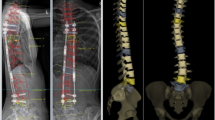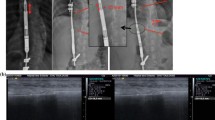Abstract
Purposes
Magnetically controlled growing rods (MCGR) allow controlled distraction of the immature spine for the treatment of early onset scoliosis. This study’s primary aim was to determine the disparity between ‘true’ (TD) and ‘intended’ (ID) distraction. The secondary aim was to assess truncal growth and development during sequential lengthening.
Methods
Twenty-one patients with a maximum follow up of 37 months were included in the study. Patients in the study underwent three monthly distractions. The amount of TD was determined by measuring the expansion gap on dedicated fluoroscopic images of the actuator. The total TD to date was compared to the ID measurement reported on the external adjustment device (EAD). Weight, sitting and standing heights were recorded at each distraction.
Results
The average number of three monthly distractions was 8. The true to intended distraction ratio was calculated as 0.33. Patients who had undergone previous surgery gained less distraction with a ratio of 0.30 compared to patients undergoing MCGR as a primary procedure with a ratio of 0.35. Weight, sitting and standing heights increased in all patients by an average of 3.1 kg, 2.3 and 5.2 cm per year. The Cobb angle following surgical correction was maintained in 19 of 21 patients at the latest follow-up.
Conclusions
The TI ratio of 0.33 suggests that for every unit of distraction registered on the EAD approximately 33 % of true distraction occurs in vivo. Increases in sitting and standing heights were observed in all patients in the study.

Similar content being viewed by others
References
Bess S, Akbarnia BA, Thompson GH et al (2010) Complications of growing-rod treatment for early-onset scoliosis: analysis of one hundred and forty patients. J Bone Joint Surg Am 92:2533–2543. doi:10.2106/JBJS.I.01471
Noordeen HM, Shah SA, Elsebaie HB et al (2011) In vivo distraction force and length measurements of growing rods: which factors influence the ability to lengthen? Spine 36:2299–2303. doi:10.1097/BRS.0b013e31821b8e16
Sankar WN, Skaggs DL, Yazici M et al (2011) Lengthening of dual growing rods and the law of diminishing returns. Spine 36:806–809. doi:10.1097/BRS.0b013e318214d78f
Dimeglio A (2001) Growth in pediatric orthopaedics. J Pediatr Orthop 21:549–555
Cheung KM-C, Cheung JP-Y, Samartzis D et al (2012) Magnetically controlled growing rods for severe spinal curvature in young children: a prospective case series. Lancet 379:1967–1974. doi:10.1016/S0140-6736(12)60112-3
Dannawi Z, Altaf F, Harshavardhana NS et al (2013) Early results of a remotely-operated magnetic growth rod in early-onset scoliosis. Bone Joint J 95-B:75–80. doi:10.1302/0301-620X.95B1.29565
Akbarnia BA, Cheung K, Noordeen H et al (2013) Next generation of growth-sparing techniques: preliminary clinical results of a magnetically controlled growing rod in 14 patients with early-onset scoliosis. Spine 38:665–670. doi:10.1097/BRS.0b013e3182773560
Akbarnia BA, Mundis GM, Salari P et al (2012) Innovation in growing rod technique: a study of safety and efficacy of a magnetically controlled growing rod in a porcine model. Spine 37:1109–1114. doi:10.1097/BRS.0b013e318240ff67
Thakar C, Sonecha S, Rolton D (2014) The fluoroscopic technique for monitoring distraction of a non-invasive lengthening device in early onset scoliosis. Open Med 1:23–28
Author information
Authors and Affiliations
Corresponding author
Ethics declarations
Conflict of interest
None.
Rights and permissions
About this article
Cite this article
Rolton, D., Thakar, C., Wilson-MacDonald, J. et al. Radiological and clinical assessment of the distraction achieved with remotely expandable growing rods in early onset scoliosis. Eur Spine J 25, 3371–3376 (2016). https://doi.org/10.1007/s00586-015-4223-4
Received:
Revised:
Accepted:
Published:
Issue Date:
DOI: https://doi.org/10.1007/s00586-015-4223-4




